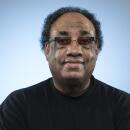Local TV dials into fire news
- Share via
Local television news devoted nearly continuous live coverage throughout much of Monday to the fires raging across seven Southern California counties as the crisis led to the cancellation of most regular daytime programming, cut into advertising revenues and pushed newsrooms to their limits.
In a massive news effort not seen since a similarly devastating series of blazes four years ago, local TV stations broadcast a grimly familiar roll call of scenes and vowed to continue to do so as long as events dictated it. Beginning midmorning Sunday, most TV screens were filled with images of homes burning, hillside infernos, scrambling evacuees, Super Scooper airplane water drops and impromptu news conferences with officials including local fire personnel and Gov. Arnold Schwarzenegger.
As with other stations, KNBC-TV Channel 4 deployed almost all of its news operation for fire coverage. The NBC Universal owned-and-operated station broke from its wall-to-wall fire coverage only for a few hours of NFL football and live “Today” show feeds.
“This is what local television is supposed to be about,” said KNBC news director Bob Long.
Except for the early morning hours, duopolies such as KCBS-TV Channel 2 and KCAL-TV Channel 9 -- and KTTV-TV Channel 11 and KCOP-TV Channel 13 -- were able to run coverage on at least one of their stations over almost all of Sunday and Monday. The twin-sister station arrangement allowed both KCBS and KTTV to broadcast major sportings events -- the NFL for CBS and the American League Championship Series for Fox -- Sunday without losing fire coverage.
On Monday, KABC notably bumped its afternoon syndicated hit “Oprah” for fire coverage. It used a news scrawl to alert viewers that preempted daytime soaps could be seen on the network’s sister cable stations. But KTLA-TV Channel 5 scaled back by midafternoon Monday, returning to its regular daytime programs. (KTLA and the Los Angeles Times are owned by Tribune Co.)
The scope, unpredictability and ferocity of the fires exhausted news crews, leaving even the largest local operations scraping for extra bodies.
“Everybody that is on our list -- staff, freelance, anybody who has ever worked for us -- is getting a phone call, ‘Hey, can you come in?’ ” said Paul Button, KCBS’ assistant news director. “We’ve got all our live trucks, both choppers out there. Everything feels very, very taxed.”
The winds make this fire especially dangerous for reporters to cover. Jose Rios, KTTV’s vice president of news, said: “It can look like the fire is laid down and then, bam, it’s back up again.”
Supplies and logistics made reporting even more difficult. “Goggles and face masks just don’t do it,” KNBC’s Long said. “The conditions are appalling, and they’re trying to talk through all this smoke.”
With such widespread attention from the local channels, much of the challenge for news stations was making their coverage distinctive. News anchors provided the most obvious separation, but some stations tried to emphasize certain elements more than their competitors.
“We want to keep a human face on the story,” said Rich Goldner, news director for KTLA, working without longtime signature anchor Hal Fishman, who died earlier this year. “There’s only so many times we can see water drops from a fixed-wing aircraft.”
Even more than the 2003 fires, the Internet has taken on a greater role in this blaze, with the stations offering live streaming video of their newscasts online. The Internet’s ability to deliver specific information quickly about road or school closures has greatly enhanced the efficiency of their coverage, news directors say.
The fire coverage demands that advertising be shelved. Stations did not comment on how great their losses might be.
“We’re burning through money here,” said KNBC’s Long.
More to Read
The biggest entertainment stories
Get our big stories about Hollywood, film, television, music, arts, culture and more right in your inbox as soon as they publish.
You may occasionally receive promotional content from the Los Angeles Times.











